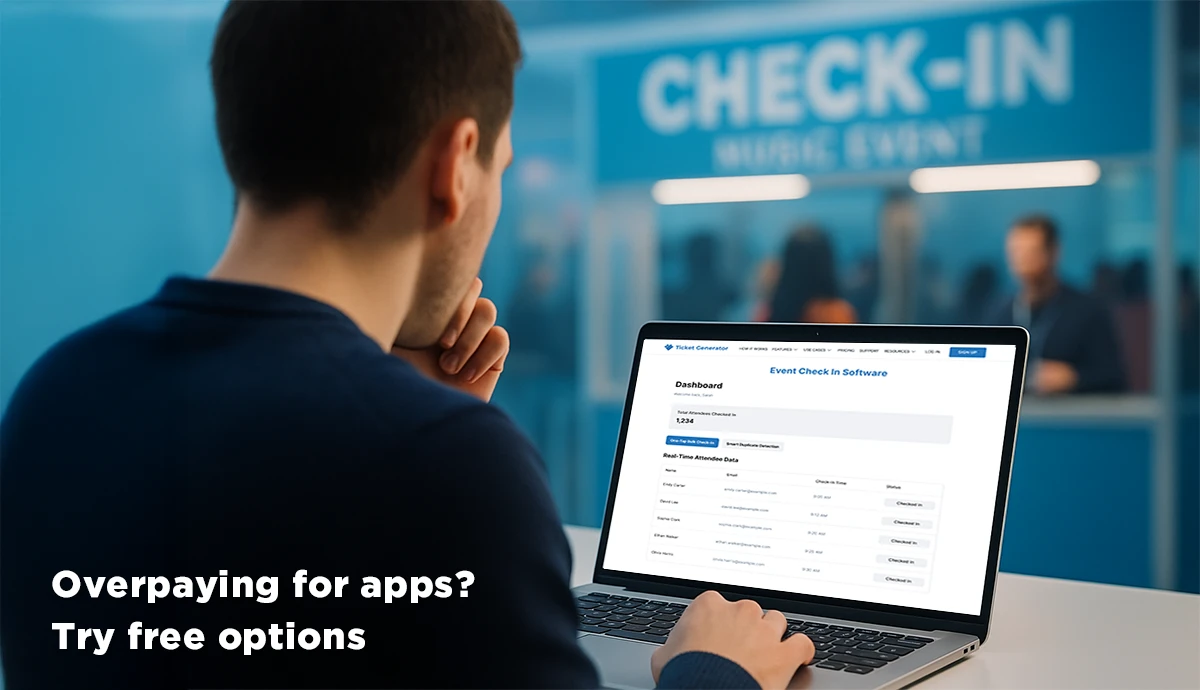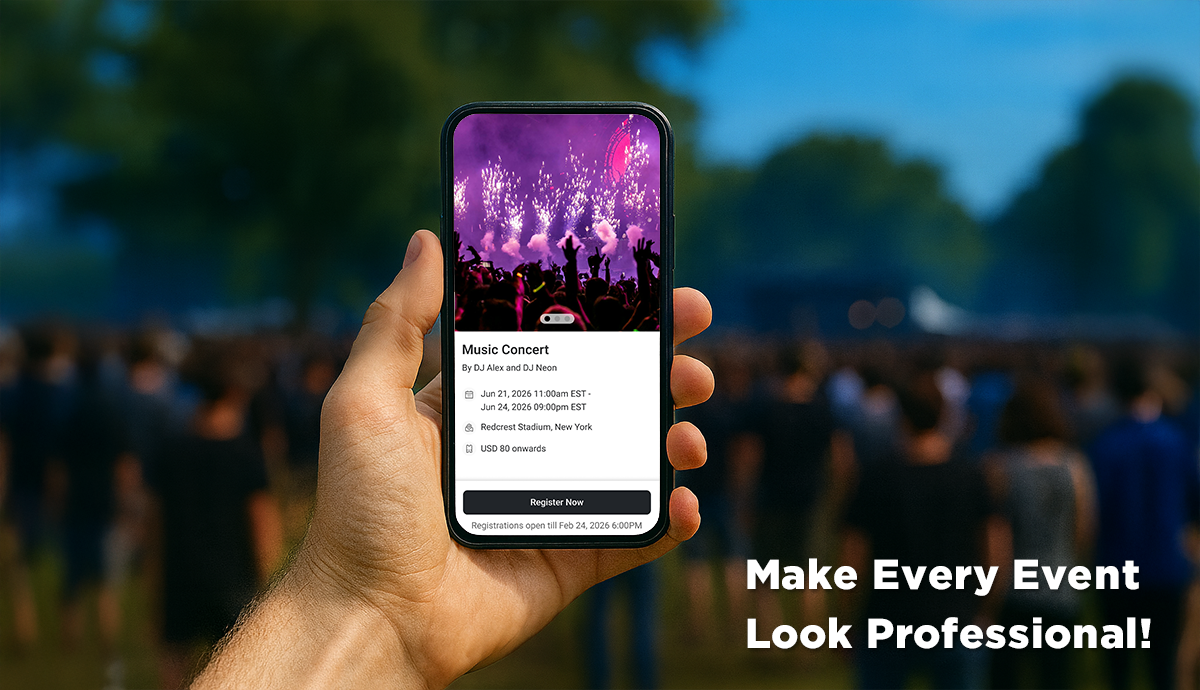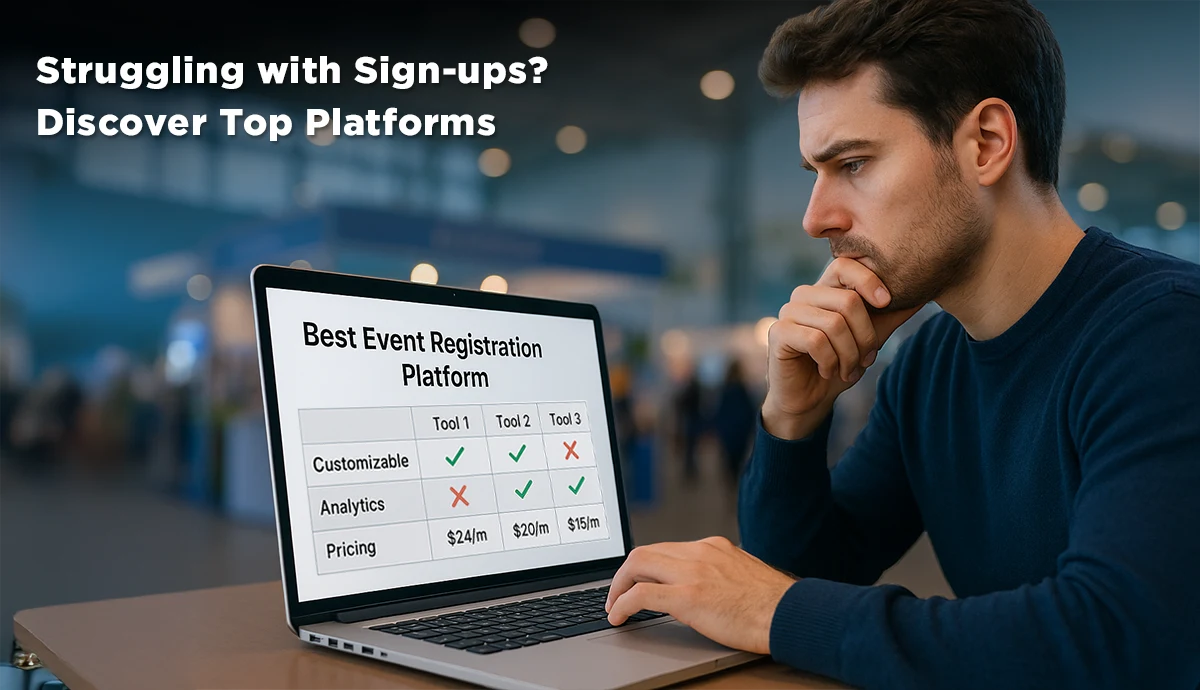Picture this: 200 guests waiting outside your venue. The registration desk is chaos. Your volunteer with the printed list can't find names fast enough. Someone's checking their phone for the fifth time. The line's getting longer, not shorter.
Sound familiar?
You're not alone. In 2025, as event management trends shift toward seamless digital experiences, event check in software free seems like the obvious solution. After all, why pay for something when free options exist, right?
Here's the thing—after analyzing dozens of platforms and talking to event organizers who learned the hard way, we discovered that "free" rarely means what you think it means. This guide cuts through the marketing fluff to show you exactly what free event check in software actually delivers, what it doesn't, and when it makes sense to use it.
Whether you're planning a 30-person workshop or a 500-guest conference, you'll learn which event check-in system fits your needs without wasting time on solutions that fail when you need them most.
Let's dive in and find out what actually works.
A. The hidden costs of manual check-ins
Let's talk about what manual check-in really costs you.
Sure, checking names seems simple. Paper list or Excel sheet on a laptop—takes 30-60 seconds per person when things go smoothly. But for 200 guests? That's over 3 hours of total waiting time. And that's if everything goes perfectly.
It never does.
Someone's name is spelled wrong. Another registered under their company name. Someone else insists they signed up but isn't on the list. Now that 30-second check takes 3 minutes. The line grows. People get restless.
Think about the events you attend. Professional conferences have smooth digital check-ins. Small community events use clipboards or laptops with spreadsheets. Which one makes you feel confident about what's coming next?
1. Paper lists create obvious problems
You can't read someone's handwriting. Names get checked off in the wrong row. Coffee spills on your list. Someone loses page two. You count attendees manually. Twice. Because the numbers don't match.
3. Excel sheets aren't much better
Sure, you can search names with Ctrl+F. But your laptop battery dies. WiFi doesn't work and your cloud backup won't load. You accidentally sort the wrong column and now everything's scrambled. Multiple volunteers? Good luck keeping their separate Excel files synchronized.
Want to follow event management best practices? Manual systems fail you. Can't find someone's name? The whole line stops. Mark someone present in the wrong row? Your count is wrong. Need to know who hasn't arrived? Time to scroll through hundreds of rows while people wait.
3. Then comes the domino effect
Late check-in means late start. Late start means rushed sessions. Rushed sessions mean confused attendees. Confused attendees write bad reviews. Bad reviews hurt future events.
One coordinator told us: "We used Excel for 150 guests. Seemed smart. Then the laptop froze. We had no backup. People waited 20 minutes while we restarted everything. Some just left."
4. Your team pays the price too
Instead of welcoming guests warmly, they're stressed. They're searching spreadsheets. Apologizing. Making excuses. That stress spreads to your guests. It sets a tone. A bad one.
Manual check-in—whether paper or Excel—isn't just slow. It's risky. Lost time. Technical failures. Angry guests. All because you wanted to save a few dollars on proper tools.
B. Free check-in software: What's actually free?
Here's what free event check in app providers don't advertise in bold letters.
1. Core features you might get
Most free event check in software includes basic attendee list management for events under 100 people. You can usually upload names, mark people as checked in, and view a simple attendance count. Some platforms include QR Code scanning—but only through a single device.
That's often where "free" ends.
2. The fine print nobody reads
Free tiers are designed as teasers. They give you just enough functionality to start, then hit you with limitations right when you can't turn back. Here's what typically happens:
Single user access: Only one person can check in guests. Add another volunteer? That's a paid upgrade.
No customer support: Problem during your event? Free users get help documentation, not human assistance.
Forced branding: Your check-in screen shows their logo, not yours.
Data limitations: Export your attendee list? Premium feature.
Update restrictions: Need to add walk-in registrations? Many free plans don't allow adding attendees on event day or limit you to the original list.
3. Free vs freemium: The crucial difference
True "free" (like Google Forms) gives you basic functionality forever with no hidden costs. Freemium event attendance tracking free platforms operate differently—they're built to frustrate you into upgrading.
Freemium platforms track your usage patterns. They know exactly when you'll hit pain points. That "upgrade now" popup appearing during check-in? That's not coincidence. It's designed to catch you when you're desperate and willing to pay.
One organizer shared: "The free plan looked perfect for our 75-person event. Mid-registration, we discovered we couldn't add our second check-in station without upgrading. With guests waiting, what choice did we have?"
Understanding this distinction helps you avoid nasty surprises when implementing your event management process.
C. What you're missing with free check-in tools
Free event check-in systems work for small events. But they lack the features that make professional events run smoothly. Here's what you won't get with free tools:
1. QR Code scanning
QR Codes are the fastest way to check in guests. Show phone, scan, done. Three seconds instead of thirty. Much faster than searching names manually.
But here's the reality: free event check in app options might offer QR scanning on just one device. Need scanning at multiple entrances? That's a premium feature. Your free plan keeps you limited to one entry point.
2. Multi-device synchronization
Professional events need multiple check-in stations. Main entrance, VIP door, accessible entry, staff entrance. When someone checks in at one spot, every station needs that update instantly. This prevents duplicate entries and keeps counts accurate.
Free platforms limit you to one device. Your team can't coordinate. Each volunteer works alone with no shared information. It creates confusion and slows everything down.
3. Real-time attendance tracking
Knowing your exact headcount matters. How many people are inside right now? When did most arrive? Who hasn't shown up? Premium event attendance tracking answers these questions with live dashboards.
Free versions give you a basic list. Sometimes a simple count. No patterns. No insights. No data to improve your next event. You're working blind.
4. Offline functionality
Internet problems happen. WiFi stops working. Cell towers overload. Your perfect venue has no signal at the entrance. It's frustrating but common.
Professional event entry management tools store data locally and sync when reconnected. Your event continues smoothly. Free tools need constant internet. No connection means no check-in. Your event stops completely.
5. Data export and integration
After your event, you need attendee information. Thank-you emails. Feedback surveys. Reports for sponsors. Planning for next year.
Premium platforms export data in any format. They connect with email tools, CRMs, and spreadsheets. Everything flows automatically.
Free platforms might let you copy names manually. No bulk export. No automation. Hours of manual data entry. Some don't let you export at all.
These features make the difference between smooth and stressful events. They're essential for a professional event management process. But free tools simply don't include them.
D. Free solutions that actually work
Not all free event check in software is created equal. After testing dozens of platforms, we found four that actually deliver on their promises—with very different strengths and limitations.
Here's what each platform really offers:
Eventbrite dominates the free event check in app market. Unlimited attendees for free events. QR Code scanning. Real-time sync across devices. Perfect until you charge admission—then it's 3.7% plus $1.79 per ticket. That $50 charity ticket? You lose $3.50 to fees.
Ticket Tailor offers a middle ground. Free events stay free with professional-looking pages (up to 5,000 tickets annually). For paid events, their $0.85 per ticket beats Eventbrite. But add payment processing (2.9% + $0.30), and costs still mount. Works best for small to medium paid events where every dollar counts.
Zoho Backstage packs surprising features into their free event check-in system. QR Codes, session management, and basic analytics—all free for events under 100 people. The catch? Hard stop at 100 attendees. Need 101? That's their Essentials plan at $119 monthly minimum. Sessions also cap at 45 minutes on the free plan.
Google Forms isn't really event software. It's a form builder you can use for basic registration. Completely free forever, but completely manual too. No QR Codes. No automated check-in. You'll search names on a spreadsheet while people wait. Only works for casual meetups under 30 people.
The reality? These free tools work for specific situations. Community events? Try Eventbrite. Small paid events? Consider Ticket Tailor. Corporate training under 100 people? Zoho might fit. Casual book club? Google Forms is fine.
But when you need reliability, speed, and professional features without surprise fees, that's when transparent paid solutions like Ticket Generator make sense. You know exactly what you'll pay—starting at $0.60 per ticket, dropping to $0.25 for volume.
Choose based on your actual needs, not just the word "free."
E. Speed hacks for faster check-ins
Whether using free event check in software or paid solutions, these strategies slash your check-in time:
1. Pre-register everyone online
Stop collecting names at the door. Set up online registration two weeks before your event. Use Google Forms if you must, but get those names in advance. This alone cuts check-in time by 60%.
Build your registration into your event management software workflow for seamless data flow.
2. Send QR Codes 48 hours early
Email attendees their QR Codes two days before the event with clear instructions: "Save this to your phone for fast entry." Include a backup PDF attachment they can print. Morning-of reminder: "Don't forget your QR Code for quick check-in!"
Tip: Include the QR Code in calendar invites so it's impossible to forget.
3. Create multiple check-in points
One line creates bottlenecks. Set up multiple stations:
- A-H last names: Station 1
- I-P last names: Station 2
- Q-Z last names: Station 3
- VIP/Speaker entrance: Station 4
Even with basic event check-in system tools, this division prevents crowding.
4. Train your team properly
Fifteen minutes of training saves hours of confusion. Show volunteers:
- How to handle QR scan failures (manual lookup)
- What to do with walk-in registrations
- How to manage lost tickets
- When to escalate problems
Create a simple cheat sheet with common issues and solutions. Post it at each station.
Smart organizers using AI tools for event management automate much of this process, but these manual hacks work with any system.
F. Red flags: When free isn't worth it
Some situations make free event check in software a liability, not an asset:
1. Your event sells tickets
The moment you charge admission, "free" platforms want their cut. Processing fees range from 2.5% to 5% plus fixed amounts. That charity fundraiser selling $50 tickets? You're paying $2-3 per ticket in fees. Multiply by 200 guests—suddenly that "free" platform costs $400-600.
2. You're expecting 100+ attendees
Free tiers hit limits around 100 people. But here's what they don't tell you: limits aren't just about headcount. It's also about:
- Check-in speed (one device can't handle 100+ people quickly)
- Data reliability (free platforms often lack redundancy)
- Support availability (no help when things go wrong)
3. Multiple entrances are necessary
VIP entrance, general admission, vendor access, staff entrance—real events have multiple entry points. Free event check in app platforms limit you to one device or charge per additional user. You'll either create dangerous bottlenecks or pay for upgrades.
4. Professional image matters
Your check-in process is your first impression. Free platforms mean:
- Their branding, not yours
- Generic confirmation emails
- Basic or no customization
- Amateur appearance
When appearance affects your credibility, free becomes expensive. Professional events need professional tools.
5. You're managing multiple events
Running a series? Managing multiple events with free tools means:
- No data continuity between events
- Repeated manual setup
- No learning from past events
- No unified reporting
One organizer learned this painfully: "We ran monthly workshops using free tools. By month three, we spent more time managing different platforms than planning actual content."
Understanding why to use AI for event management becomes clear when you hit these limitations repeatedly.
G. People also ask
1. Is there any completely free event check-in software forever?
Google Forms is completely free forever but it's entirely manual—no QR Codes, no automated check-in. For actual event check in software free with features, every platform has catches: attendee limits, feature restrictions, or fees for paid events. "Forever free" with full features doesn't exist.
2. Can I use Google Forms as a check-in system?
Yes, but it's primitive. Create a form for attendees to enter their name on arrival. You'll need to manually search the spreadsheet to verify attendees. Works for casual events under 30 people. For anything larger, it's unprofessional and time-consuming.
3. What's the typical attendee limit on free plans?
Most free event check in software caps at 50-100 attendees. Zoho allows 100 but limits sessions to 45 minutes. Eventbrite and Ticket Tailor have no limits for free events, but features are so basic that managing over 100 people becomes chaotic.
4. Why do platforms charge fees for paid events but not free ones?
Simple business model: platforms make money from transaction fees. Free events generate no revenue, so they offer basic features hoping you'll upgrade. When you charge for tickets, they take 2-5% because they know you're making money.
5. How do I switch from free to paid mid-event if needed?
Don't try. Switching platforms during an event is disaster. If using free tools, upgrade within the same platform if you hit limits. Better approach: start with scalable tools like Ticket Generator that grow with your needs. Planning ahead prevents panic upgrades.
H. Conclusion
Here's the truth about event check in software free: it works for book clubs, casual meetups, and free community events under 50 people. The moment your event grows, charges admission, or needs professional features, free becomes a costly gamble.
Your time has value. Your reputation has value. Your attendees' experience has value.
For small, free, casual events? Use Eventbrite or Google Forms and accept the limitations.
For everything else? Invest in an affordable, transparent solution that grows with your needs.
Ready to upgrade from check-in chaos? Ticket Generator offers honest pricing, real features, and support when you need it. No hidden fees, no surprise limits, no platform games.
Stop gambling with free tools that fail when it matters. Start with a solution built for real events.









.gif)




